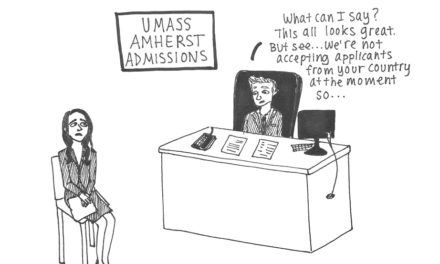When I was a freshman, I had a morning routine. I would get out of bed 15 minutes before my first class, brush my teeth and run out the door after throwing on the first sweatshirt I could find. After that, I would go to the DUC and purchase an iced coffee and hash browns. One of these mornings would cost me a grand total of four dollars, not accounting for the cost of the toothpaste.
If you are currently a senior or alumnus/a of Emory University, nothing about such a morning routine likely seemed strange to you. My younger peers, however, were likely struck by the impossibility of the last line because a coffee and pastry will now run the average DUC-goer closer to nine bucks. I will remind them, however, that we live in a dynamic and everchanging world and that three years ago was a markedly different time — a time when our mornings were guided by the gentle pink and orange glow of Dunkin’ Donuts as opposed to the harsh white glare of the Kaldi’s goat.
Why, I wonder, did this drastic change in caffeine dealers come to pass? An innocent change in student tastes, or the evolving, complex coffee palette of the average Emory student? While those reasons would be pleasant and flattering, I believe they are ultimately inappropriate, as I know no more about regional specialty chai today than I did three years ago. I’d like to discuss some possible economic reasons for this switch from the University’s perspective, and in doing so hopefully shed light on what I believe to be a larger trend toward the reduction in quality of student life at Emory.
In my three years at Emory, the exchange rate between United States dollars and Dooley dollars has remained a constant 1:1. As the United States dollar has gotten stronger since 2013, however, the purchasing power of our Dooley dollars on campus has been intentionally and drastically depressed. A coffee the size of my head used to cost 2 Dooley dollars at Dunkin’ Donuts, and now the mere thimble I can purchase at Kaldi’s costs a whopping 4 Dooley dollars. Long past are the days of cheap and fast chicken fingers at Zaya’s, as the installation of a new Kaldi’s earlier this year has ushered in a terrifying new era in which we are expected to pay $9 and wait 20 minutes for a small box of nachos.
You get the point: even though the price of my Dooley dollars has not changed throughout my time at Emory, I now get much less bang for my Dooley-buck, so to speak, as compared to my freshman year. By replacing traditional dining options with more expensive specialty bistros, Emory has essentially gentrified its food services and materially decreased the value of its dining options. This seems to be, at best, a marketing ploy for the school, as tours through the DUC can point out the quaint coffeehouse ambiance created by groups of students sitting on burlap sacks and, at worst, simply a plan to squeeze more money out of students.
The latter seems far more likely. When students purchase a 750 Dooley dollar meal plan, they are essentially guaranteeing the school’s dining services 750 in business. After this purchase is made, there are only two ways the University can increase its per-capita value per student meal plan. The first is exceedingly unlikely, as it would require students not to spend all of their Dooley Dollars. If students have extra Dooley dollars at the end of any given year, they have paid for food and not consumed it, which translates to cost-free profit for the school, assuming that this food is purchased by another student and not simply thrown away.
The second and far more likely option is that students burn through their entire stash of Dooley Dollars and begin to shell out cold hard cash to buy food and coffee around campus and thus continue to contribute to dining services’ profits. Even if Emory doesn’t receive a direct cut of each sale from Kaldi’s, students who spend all of their Dooley dollars there will end up paying real money for food at Emory-run eateries such as Cox Hall. Additionally, the higher prices are funneled to Emory indirectly, as Kaldi’s can only continue paying for its contracted spaces in the DUC and Zaya’s if they are producing profit, and their business model requires charging higher prices in order to do so. Dunkin’ managed to create such a profit while charging half the price, so clearly these price differences are the result of different business ideologies, not economic necessity.
The counterargument would, of course, be that even though we pay more than we used to, we are now offered better quality food. While this is undoubtedly true, I’d argue that it’s irrelevant. Was the quality of the coffee at Dunkin’ Donuts ever really an issue? I have trouble believing that there has ever been a hungover student at any point throughout Emory’s history that would rather debate the finer, subtler differences between Arabica and Robusta coffee beans with a Kaldi’s barista and then pay five dollars for the experience as opposed to muttering “medium iced-coffee” at Dunkin’ and walking away a mere two dollars poorer.
These changes represent a move toward quality nobody asked for at a price that many students can’t afford or don’t want to pay. While this shift undoubtedly results in more money in the University’s pocket or a nice photo for a campus brochure, it does so by intentionally reducing the quality of life for its students. When you consider the reality that these negative impacts will be felt most intensely by the University’s low-income students, these changes seem even more uncalled for and flagrantly apathetic in regards to the impact they have on student life.
Tyler Zelinger is a College senior from Commack, New York.





